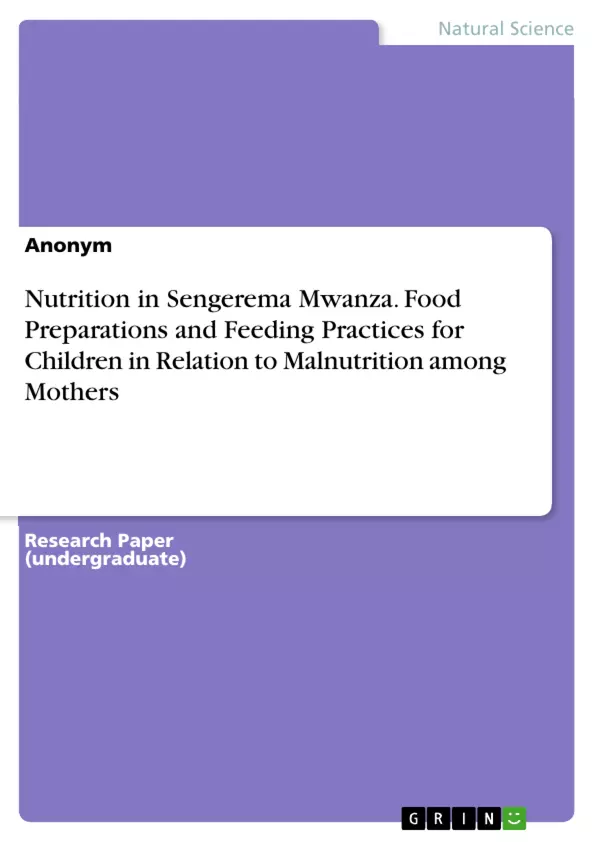Major problems facing under five children in Tanzania are overnutrition and undernutrition the latter being the leading one, according to the Tanzania National Nutrition Survey (TNNS) 2018, 31,8 percent of under-five children are stunted, which is a significant decrease from 34,7 percent in 2014, it was approximated that the number of children who were acute malnourished had increased from 440,000 in 2014 to 530,000 in 2018. At the national level, the prevalence of underweight among children aged 0-59 months was at 14,6 percent in 2018, which was significantly higher than the 13,4 percent in 2014, 2,8 percent of under-five children are overweight and large number being found in urban areas.
Firstly, to investigate the socio-economic, cultural, and environmental factors contributing to malnutrition in Mwanza Region. Secondly, to explore food preparation practices and their impact on nutrient retention, and adequacy and access nutrition status. Lastly, to identify feeding practices, including breastfeeding and complementary feeding, and their association with under-5 malnutrition
A cross-sectional study design was established, that employed quantitative and qualitative approach. Data were collected using semi structured questionnaires, by using cross sectional study design. A total of 440 respondents were involved in the study. The information obtained was then analyzed using EXCEL, SPSS Version 20 and ENA for SMART Programme and interpreted by using the WHO Standards (2006). The converted nutritional data were transformed into Z-scores of the indices; height-for-age, weight-for-height and weight-for-age to identify associated factors of malnutrition.
Inhaltsverzeichnis (Table of Contents)
- DECLARATION
- CERTIFICATION STATEMENT
- LIST OF TABLES AND FIGURES
- ACKNOWLEDGEMENTS
- ABSTRACT
- ABBREVIATION
- OPERATIONAL DEFINITION
- CHAPTER ONE
- 1 INTRODUCTION
- 1.1 BACKGROUND INFORMATION
- 1.2 PROBLEM STATEMENT
- 1.3 RATIONALE OF THE STUDY
- 1.4 RESEARCH QUESTION
- 1.5 RESEARCH OBJECTIVES
- 1.5.1 BROAD OBJECTIVE
- 1.5.2 SPECIFIC OBJECTIVES
- CHAPTER TWO
- 2 LITERATURE REVIEW
- 2.1 Factors For Malnutrition
- 2.2 Prevalence of Malnutrition
- 2.3 Intervention Towards Malnutrition
- CHAPTER THREE
- 3 RESEARCH METHODOLOGY
- 3.1 Study Area
- 3.2 Study Design and Project Duration
- 3.3 Study Population
- 3.4 Selection Criteria
- 3.5 Sample Size and Sampling Procedure
- 3.5.1 Sample Size
- 3.5.2 Sampling Procedure
- 3.6 Data Collection Procedure
- 3.7 Data Analysis Procedure and Statistical Analysis
- 3.8 Ethical Considerations
- 3.9 Dissemination of Results
- CHAPTER FOUR
- 4 RESULTS
- 4.1. Demographic Characteristics of the Study Population
- 4.2: Food Preparation Practices and Their Impact on Nutrient Retention and Adequacy
- 4.3 Feeding Practices, Including Breastfeeding And Complementary Feeding And Their Association With Under-5 Malnutrition
- 4.4: Selected Immunization Administered to Children Under 24 - 6 months of age
- 4.5 Nutrition Status Of Children
- CHAPTER FIVE
- 5 DISCUSSION CONCLUSION AND RECOMMENDATION
- 5.1 Discussion
- 5.2 Limitation of the Study
- 5.3 Conclusion
- 6.2 Recommendations
- REFERENCES
Zielsetzung und Themenschwerpunkte (Objectives and Key Themes)
This research report aims to investigate the relationship between food preparation and feeding practices for children under five years old and the prevalence of malnutrition among mothers in the Sengerema District of the Mwanza Region. The study seeks to understand the factors contributing to malnutrition and identify potential interventions to address this issue. The specific objectives include:
- To determine the prevalence of malnutrition among mothers and children under five years old in the Sengerema District.
- To explore the relationship between food preparation and feeding practices and the occurrence of malnutrition.
- To analyze the impact of breastfeeding and complementary feeding practices on child malnutrition.
- To assess the nutritional status of children in the study area.
- To identify potential interventions and recommendations to address malnutrition in the Sengerema District.
Zusammenfassung der Kapitel (Chapter Summaries)
Chapter One introduces the study's background, rationale, research question, and objectives. It provides context for the research by discussing the prevalence of malnutrition in Tanzania and highlighting the specific problem of malnutrition in the Sengerema District.
Chapter Two presents a comprehensive literature review on factors contributing to malnutrition, the prevalence of malnutrition, and existing interventions to address it. It draws on relevant studies and research findings to establish a theoretical framework for the study.
Chapter Three details the research methodology used in the study. It describes the study area, design, population, sampling procedures, data collection and analysis methods, ethical considerations, and plans for disseminating the research findings.
Chapter Four presents the results of the study, highlighting the demographic characteristics of the study population, food preparation practices, feeding practices, immunization status, and nutritional status of children. It also analyzes the relationships between these variables.
Chapter Five discusses the study findings in detail, drawing conclusions from the research, and identifying limitations. It also provides recommendations based on the findings, suggesting potential interventions to improve nutrition in the Sengerema District.
Schlüsselwörter (Keywords)
The research focuses on the important themes of under-five malnutrition, food preparation and feeding practices, breastfeeding and complementary feeding, and nutritional status of children. It utilizes a mix of qualitative and quantitative methods to explore the relationships between these factors and the prevalence of malnutrition in the Sengerema District of the Mwanza Region. The study also addresses the significance of maternal education, access to healthcare, and other socioeconomic factors that impact child nutrition.
- Quote paper
- Anonym (Author), 2022, Nutrition in Sengerema Mwanza. Food Preparations and Feeding Practices for Children in Relation to Malnutrition among Mothers, Munich, GRIN Verlag, https://www.hausarbeiten.de/document/1402554


